I first noticed it on May 27, 2016. It contained one half-grown chick. One of the parents (likely the female which usually tends to the young) accompanied it in the nest:

The other adult stood watch on another light standard nearby:
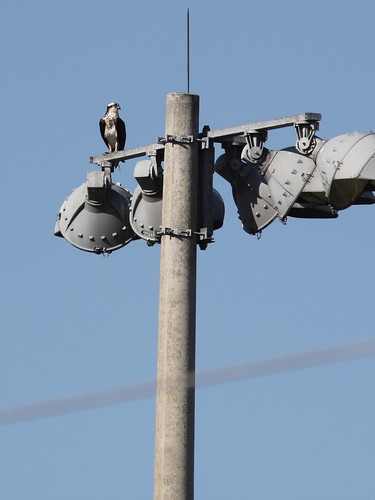
I then returned to our second home in Illinois and never learned whether the young Osprey successfully fledged. I next photographed the nest on February 25, 2018. It was much more substantial. An adult posed on it:

On April 10, 2018 an adult was barely visible roosting high on the nearest pole. The nest is on the one behind it in the center of the four pitches (click on image to enlarge). The Ospreys did not seem to be disturbed by the soccer players and spectators. The next two years they chose to nest on the more distant pole in the far right corner of the field:
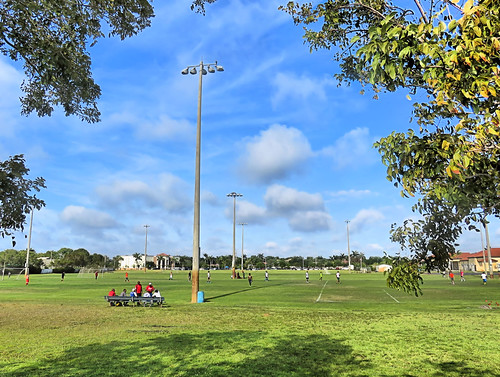
Two nearly full-grown Ospreys occupied it on June 9, 2018:

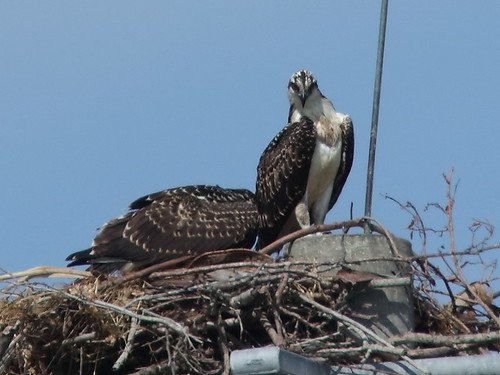
During the 2018-2019 breeding season, the Ospreys started working on the nest during the winter. One adult rested in it on January 26, 2019:
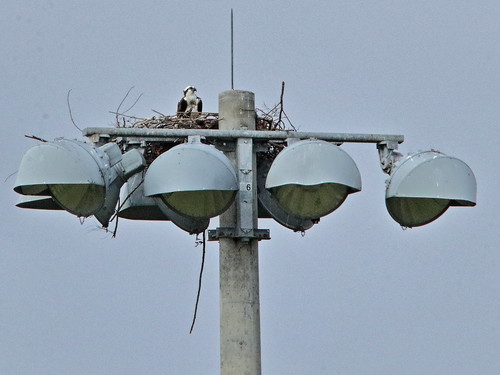
They appeared to be incubating eggs by March 16, 2019. Ospreys normally lay three eggs. Since their incubation period varies from 34-40 days, they may have had another week or two to go when I took this photo of an adult deep in the nest on April 14, 2019:
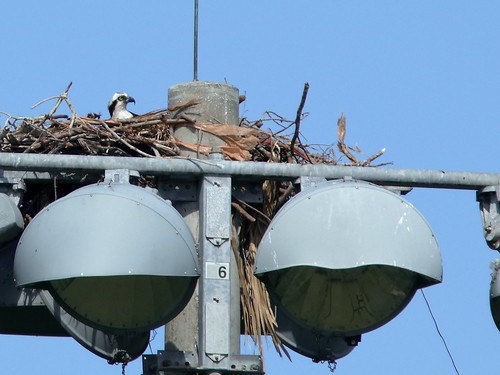
I often checked the nest when I drove by, but could only see the head of an adult which I assumed was either incubating or brooding small chicks. Then, on May 18 the scene was a bit disturbing. One adult, preumably the female, was standing up in the nest and loudly calling repeatedly as if excited or disturbed. By now the chicks should have been visible, but I watched carefully and never saw any:
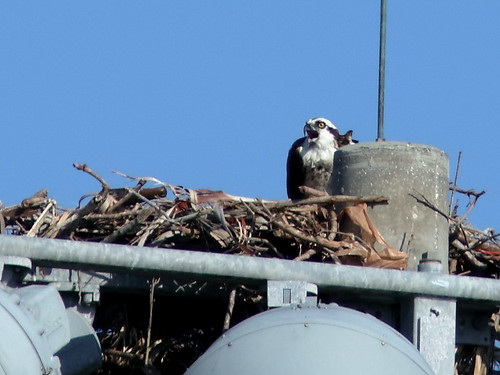
Was this adult bird begging to be fed, or was this a cry of distress? The other adult was eating a fish atop on adjacent light pole and seemed to ignore the incessant screaming. From that day on the nest appeared to have been abandoned:


After that I stopped by and twice found no Ospreys at all, and the nest was always unoccupied. Then, on May 28 I found the two adults huddled together on one of the light poles. I never found out what had happened to their offspring.

The nest platform is actually a large array of lights which can be lowered to the ground in order to service them. When hurricanes threaten or it undergoes maintenance, the entire array is lowered. Of course this destroys the nest and they must rebuild it every year.
This season the nest was completed and incubation was underway by March 2020:
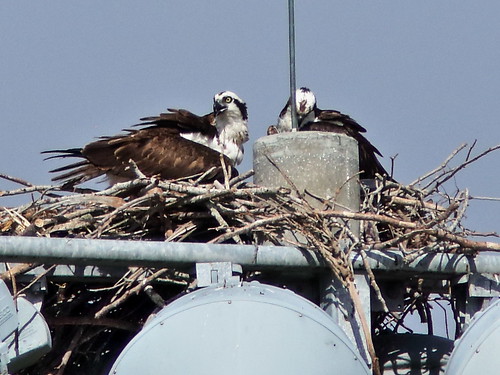
A single chick was ready to take flight in late May. Note that it has a speckled back and wings:
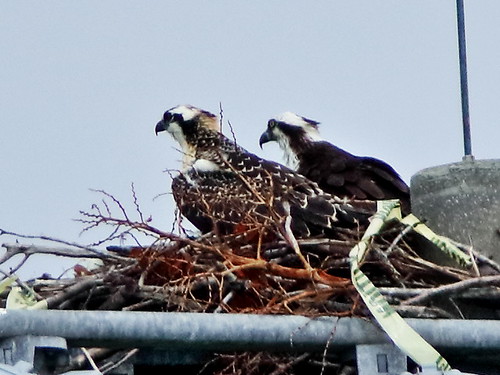
The juvenile is now flying freely. Its white feather tips create a beautiful pattern:
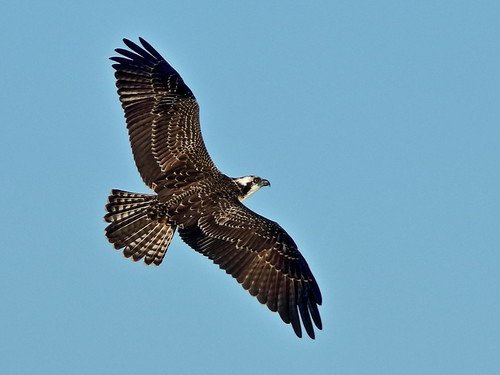
In our back yard, the Muscovy Duck which hatched out 15 ducklings last week is now down to only 7. Mortality is very high. Often none of the brood survives:

Yesterday the seven ducklings followed her along the lake shore during a storm. I obtained this photo of them through the rain-soaked window:
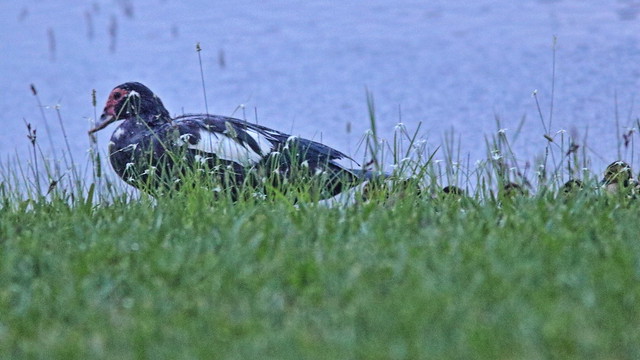
A little later, after the skies had cleared, I walked out on the patio and was surprised to see yet another Muscovy hen emerge from under the same Cocoplum bush with 8 newly-hatched offspring:

These are her eight hatchlings. Note that one is dark overall and may likely more closely resemble the wild stock:

The tops of storms moving in over the Atlantic Ocean broke the sunlight into shadows which converged over the Everglades to the west, producing an array of anti-solar (anti-crepuscular) sunbeams. The "mirrored sunrise" reflected on the lake's placid surface:
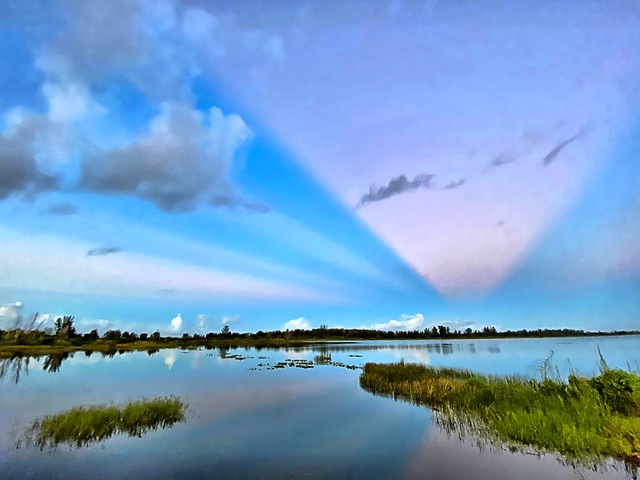
Threatening skies to the east moved in just after sunrise:

We hurried home, ahead of the menacing storm:
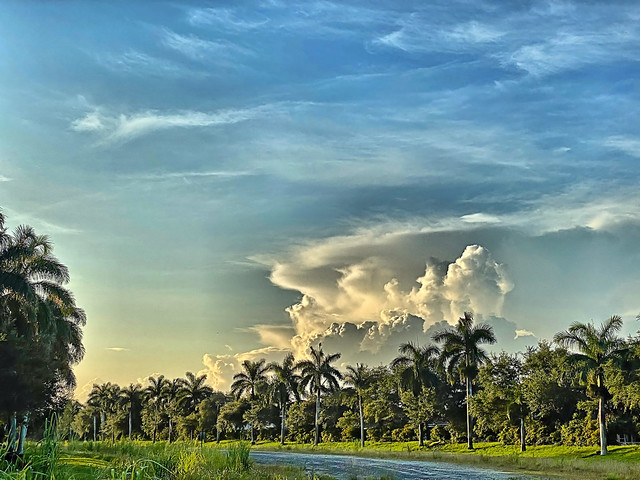
= = = = = = = = = = = = = = =
Linking to:
Fences Around the World
Skywatch Friday
Weekend Reflections
Saturday's Critters
BirdD'Pot
Camera Critters
All Seasons
Wordless Wednesday (on Tuesday)
Natasha Musing
Our World Tuesday
Please visit the links to all these posts to see some excellent photos on display
________________________________________________
________________________________________________
Please visit the links to all these posts to see some excellent photos on display
________________________________________________
So much beauty here. I love the story line about the osprey though it is sad if the baby osprey didn't survive. Your sky photos are wonderful too. I especially love the last one.
ReplyDeleteThe Osprey are fascinating. Your sky shots are amazing, wow!
ReplyDeletemagnificent
ReplyDeleteAmazing series of pics.
ReplyDeleteBeautiful sky images and reflections Kenneth. Good to know that at present there are 7 ducklings surviving still. great shots of all the Osprey. Stay safe and have a good weekend.
ReplyDeleteCool shots.
ReplyDeleteBeautiful series..Reminds me of "Quackers"..A Mallard who used to nest under a bush that was between my pond and my Florida room...sometimes 3 clutches a year..7 years..The hatchlings would go straight in to my pond (anywhere from 9-13) Then they would follow their Mom down to the wetlands through the thick grass..about 150 feet..Quite an undertaking for just having been born..About half of them survived..The snapping turtles would get them..The turtles would also come up to the house to lay their eggs..I would find the babies on my porch..Fun times..miss those days..Quackers was like a pet..I miss her
ReplyDeleteBeautiful sky shots. Interesting that the osprey can nest in the middle of so much human activity!
ReplyDeleteHello Ken,
ReplyDeleteFirst, I must say your sky images are just stunning. Great post and photos on the Osprey and their nest. It is sad when their nest are not successful, I have seen Osprey and Great Horned Owls nesting on these light poles above a soccer field in Lakeland. The ducklings are so cute, I hope the rest of them survive. Great collection of photos. Thank you for linking up and sharing your post. Enjoy your day, wishing you a happy weekend! PS, thank you for the visit and comment.
I greatly enjoyed your post! The ospreys are amazing creatures. I have never seen an osprey in real life. I hope to someday. Happy Saturday.
ReplyDeleteThis is an amazing record of the osprey. Thanks for sharing with us at IRBB.
ReplyDeletePs...the Gallinule is also the Morgen in Texas. Unless Texas donxt part of the US. Also go out to south Dakota birds and do a search for common Gallinule & you'll get nothing...search for Morgen and you'll get the bird
https://txtbba.tamu.edu/species-accounts/common-moorhen/
Auto correct changed moorhen to morgen?
DeleteYes, I saw it right away and knew what had happened (from experience!) I could not edit it and I cannot edit my own posts.
DeleteHello. Interesting post. Wonderful photos.
ReplyDeleteI always enjoy seeing birds perched on their nests high up on the lights. They are more common in the county below me close to a wetland park. I don't see them as much closer to home. As always, I just love, love, love your sky shots you end with. Have a great week and stay safe.
ReplyDeleteReally interesting account of the osprey. Enjoyed seeing the duckling photos (rooting for all of them to make it!). And those skies, oh my! Hope you are having a happy Sunday!
ReplyDeleteExcellent shots! The sunbeams are spectacular!
ReplyDeleteBeautiful pictures. The ducklings look so cute.
ReplyDeleteMarvelous photos. I love seeing the osprey shots - we don't have those here, and I'm quite fond of raptors.
ReplyDeleteNice documentation of the Ospreys, Ken! I never tire of watching them.
ReplyDeleteYour "sky-scapes" are spectacular! Looks like you may have an opportunity for more dramatic images if the forecast is correct about a tropical storm this weekend.
Stay safe!
These skies are just gorgeous! Love the creativity and guts of the ospreys for choice choice of nest to live:) A Great post Ken, even though it may feel somewhat limiting to you and sharing it will All Seasons:) Have a great weekend, Jesh
ReplyDeleteMighty Morning Ken,
ReplyDeleteIt seems it's Osprey week all the way! Another friend Trent, had posted Osprey shots too.
I'm yet to see an Osprey. Though have seen raptors like Crested Hawk Eagle, Honey Buzzard, Black shouldered Kite, Bhraminy Kite etc. Quite a few in the forests of Central India and part of my content writing work for the eco-lodges we have there.
I love your magical sky watching pictures and those are such gorgeous little ducklings.
Have a wondrous week ahead, Ken. Await your pictures for next week. They have me bowled over.
Thank you so much for linking up with us on #WordlessWednesday.
https://natashamusing.com/2020/07/natures-treasures-wordlesswednesday-wednesdaywisdom/
I love the sky photos! Have a great weekend!
ReplyDeleteI have heard about Ospreys.. seeing them up close here... Its wonderful of you to have documented the pair .. The sky photos are amazing!!
ReplyDeleteAmazing captures on this one my friend Kenneth! It is my first time to see ospreys and I did hear the word osprey on some eyeglass line but never thought it was named after a bird so thank you so much for letting me have that knowledge! I really loved that one photo that you got it looking straight at you and how I realize how high those lampposts are! I also enjoy the sky shots, and seeing the plants there look very identical with the plants here with those palms and kans grasses! Lovely!
ReplyDeleteThank you so so much Kenneth for joining this week's Timeless Thursdays! Sending you hugs for the weekend!
Fantastic sky photos!
ReplyDeleteLoving your birds, as always! The ducklings brought back memories of a house we had with a pond. The first to bring ducklings were a pair we called Fred and Ginger. They started out with 11, dad left, they dwindled to 3; after a few weeks, mom disappeared and they showed up on their own and were always together.
ReplyDeleteOver that summer we had close to 100 ducklings show up regularly with about 13 moms. That was a fun summer!
That is some bird watching. I have never seen an Osprey and thanks to your post I get to see them virtually. They definitely look good. When they keep coming back to a nest its means they feel happy and safe there. Its sad but I think they must have lost their eggs and the mother maybe grieving. No wonder the nest remained abandoned out of despair. It's good to see the hopeful couples bringing the nest back to life. The ducklings are too sweet. Its heartbreaking to know that such high mortality rate is there. I loved the post Kenneth. My love fr birds and nature sure found joy here. The sunrise and stormy skyscape are absolute beauty. I hope its was all safe during the storm. Have a great week ahead.
ReplyDeleteIt has always amazed me to see that Ospreys quite often build their nests on light poles or power line structures. These shots were amazing, but my favorite were the Muscovy ducklings, both sets and sorry to read about the mortality rate, which may be from predators (?)Those last photos of the approaching storm were beautiful and hope you made it safely home.
ReplyDelete